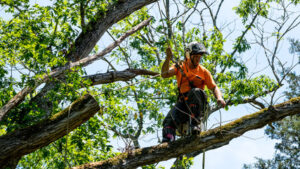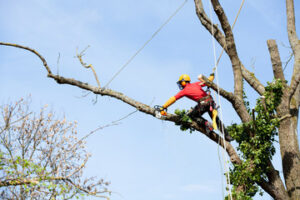Tree Trimming Irvine CA involves removing dead or diseased branches from a tree or shrub. It promotes healthy growth and enhances property aesthetics.

Regular pruning prevents limb failure during storms and high winds, and can minimize damage to structures and people. It also removes competing branches and encourages the development of a dominant central leader.
Trees are integral to landscape aesthetics, creating a natural and beautiful environment that enhances the beauty of your property. Regularly scheduled pruning is an important part of ensuring the health and visual appeal of your trees, while also promoting proper growth.
Aesthetic trimming is done primarily to improve the look of a tree. Overgrown or misshapen branches can become a nuisance and detract from the overall beauty of your property. Trimming can remove the unsightly overgrowth that often results from insufficient pruning or a lack of attention to trimming needs. By keeping your trees healthy and aesthetically pleasing, you will create a beautiful, balanced, and inviting outdoor space that increases your home’s value and curb appeal.
Regularly scheduled tree trimming also prevents disease and promotes a healthier structure. Aesthetically pleasing pruning techniques include thinning crowded areas, removing dead or dying branches, and shaping the canopy. This promotes air circulation, reduces soil compaction, and encourages new growth and healthy vigor. It also helps to eliminate limbs that hang over structures or block sightlines.
It is important to keep in mind that each tree species has its own unique appearance, and aesthetic pruning must take into account the natural shape of the tree as well as its specific growing habits. It is also essential to prune at the correct time, which varies by species. Generally, late winter and early spring are best for pruning as this is when the tree is dormant and new growth can quickly cover cuts.
Health
Tree trimming improves the health and strength of a tree. It can remove dead or diseased branches, reduce hazard risks, and enhance flower or fruit production. In addition, it increases sunlight penetration to the ground and promotes plant growth around your landscape. A professional will examine your trees and look for limbs that have become too close to power lines or buildings. They can also identify signs of rot or other diseases and make recommendations to keep your trees healthy and strong.
Trees with thick foliage can have difficulty absorbing sunlight and air, which can lead to poor health and damage. This is why it is important to trim your trees regularly. This will help the soil and other plants around your property to thrive, which can increase curb appeal and raise property values.
Weak or weakened branches can fall and damage your home during storms or strong winds. Weak or dead limbs can also pose a safety risk for you and your family, especially children and pets. Tree trimming can remove these limbs before they break off and cause damage or injury.
Regular trimming can also improve a tree’s appearance, reducing its overall density and providing more sunlight to the rest of the yard. It can also prevent the formation of unsightly bulges or cracks in the bark. A well-trained tree trimmer will use a stepwise approach to pruning, starting with the smaller limbs and working their way up to larger ones. This helps maintain a healthy, balanced shape and reduces stress on the limbs caused by wind, gravity, and other factors.
Another benefit of tree trimming is that it can help prevent tree diseases from spreading throughout the entire canopy. For example, if a fungus starts in one or more branches, it can quickly spread to other parts of the tree and threaten its health. A fungus in the heartwood of a branch is more difficult to treat than one that’s just on the outside surface, so it’s best to remove the affected limb and prevent the infection from spreading.
Safety
Tree trimming is not a simple task to undertake. It requires extensive training and familiarity with the proper use of safety equipment. Branches that are left untrimmed can fall onto homes, cars, and power lines. This can result in expensive property damage and serious injury to people and pets.
The good news is that this can be avoided with regular tree trimming. By removing damaged, dead, and crowded branches from your trees, you can keep them healthy and free of hazards that could threaten the well-being of your home and family.
Safety Guides For Trimming
Safety is a key aspect of any job, and it’s particularly important when working with sharp tools. There are many benefits to keeping your tools properly maintained and up-to-date with safety equipment, including a greater level of control, precision cutting, and less risk of injury.
Before beginning a trim, it’s important to thoroughly inspect the work area for any potential risks. Identifying hazards such as power lines, cracks in the trunk, or loose bark will help you to avoid injury or accident. Also, ensure that your PPE is ready to go for the job, such as checking the condition of helmets, protective eyewear, and other safety gear.
When preparing to cut, it’s important to mark off the danger zone with clearly marked safety barriers. It’s also recommended to have a partner on the ground who can watch for signs of trouble or a fall. Lastly, it’s best to avoid climbing or aerial access during wet, icy, or windy conditions, as these weather conditions can increase the likelihood of falling limbs and other hazards.
In addition to safety benefits, regularly pruning your trees can also improve their growth. Cutting away dead branches and removing excess and misshaped growth will promote healthy tree growth and allow for more sunlight to reach the lower canopy and ground. This will also decrease the spread of disease and insect infestations. It’s worth noting that some trees (such as birch, oak, maple, dogwood, and elm) exude a great deal of sap from the wounds caused by pruning. For this reason, it’s recommended that these types of trees are trimmed in late winter or early spring.
Property Value
The property value of a home or business is determined by a variety of factors, including curb appeal, location, amenities, and demand from potential buyers or tenants. Trees can significantly increase a property’s value by elevating its visual appeal, providing shade and character, and adding a sense of natural beauty and tranquility to an outdoor space. However, in order to maximize the property value of your trees, they must be well-maintained. Tree trimming is a key component of this maintenance, and can make a big difference in the overall appearance and health of your trees.
The most obvious benefit of tree trimming is the aesthetic effect it can have on your landscape. By removing dead or overgrown branches and shaping the crown, pruning promotes a healthy, aesthetically pleasing look that can add a lot to your property’s curb appeal. Furthermore, trimmed trees are less likely to damage your property during storms, which can be a major selling point for potential buyers.
Regular tree trimming also helps to maintain the health of your trees, allowing for better air circulation and sunlight penetration while reducing the risk of pest infestation and structural problems. Additionally, proper pruning techniques such as crown thinning and raising the canopy can make your yard easier to maintain, further increasing your property’s value.
As the leading provider of tree service in Lilburn, we can attest that a well-maintained yard is highly desirable for potential buyers. Buyers often seek properties with open spaces and clearly defined gardens, which can be difficult to achieve on a property that has overgrown trees or poorly-maintained landscaping. By investing in routine maintenance, including tree trimming, you can ensure that your yard is both safe and attractive, which will be a selling point for future buyers.
While the benefits of tree trimming are clear, many homeowners may wonder if it makes sense to have trees removed. In some cases, removing diseased or dying trees can be necessary for the safety and health of your home, resulting in higher property values. In addition, removing unwanted or unsightly trees can create more space for new plantings that will enhance the look of your yard and potentially increase its value.
